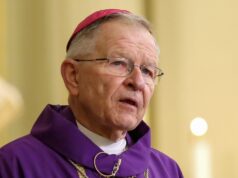ATLANTA — As their blended voices filled the chapel, its ceiling painted to resemble a star-filled night, the 10 women and men chanted: “Dum Transisset Sabbatum, Maria Magdalene et Maria Jacobi et Salome emerunt aromata, ut venientes ungerent Jesum. Alleluia.”
The 16th-century composition based on the Gospel of St. Mark drew out their voices in harmony as they sang about the three Marys visiting the tomb of Jesus Easter morning.
Director Ben Dollar interrupted the singing, encouraging choir members with instruction.
The rehearsal at the Georgia Tech Catholic Center in Atlanta was the first gathering since a busy Holy Week when the group sang from Holy Thursday to the Easter Vigil. Some came to rehearsal in shorts and sandals, others in Oxford shirts and dresses.
“When we all come back together and we make music in such a beautiful space, it really tugs on the heartstrings a little bit, even just rehearsing and messing up and having to drill stuff down,” said Terrence Connors, 25, a baritone who went from singing at the Catholic Center to being a member of the Atlanta Symphony Orchestra Chorus. Connors starts work this summer as a high school chemistry teacher.
Known as Concordi Laetitia, which is Latin for “the joy of harmony,” the group’s name comes from a Gregorian chant dedicated to Mary.
For the past months, these 20-somethings have traveled to churches in the Archdiocese of Atlanta to sing in Latin at Mass, a practice that largely disappeared from parishes two generations ago.
The chorale is rooted in the university’s Catholic Center. In 2015, the then-chaplain introduced Gregorian chant and Renaissance music to students. The young adults formed a choir to sing the unaccompanied chant for worship. A student choir sings in Latin at 9:30 a.m. Sunday Mass.
The Second Vatican Council recognized the heritage of this sacred music. Its document “Sacrosanctum Concilium,” the Constitution on Sacred Liturgy, called this tradition “a treasure of inestimable value, greater even than that of any other art.”
The document stated Gregorian chant “should be given pride of place in liturgical services” as it also said, “the church approves of all forms of true art having the needed qualities, and admits them into divine worship.”
Father Anthony Ruff, a Benedictine monk and priest who teaches theology at St. John’s School of Theology and Seminary, said Gregorian chant is valuable when it helps transform worshippers “more into the body of Christ.”
He helped write the musical guidelines “Sing to the Lord: Music in Divine Worship,” which advises parishes how to use chant in liturgy.
Chant and other musical traditions can encourage prayerful listening when it fits the purpose of Mass, he told The Georgia Bulletin, Atlanta’s archdiocesan newspaper.
“It’s not more worshipful if it’s more Latin and more mysterious. It’s more worshipful if it draws us into the mystery of the rite,” he said.
Bishops at the council understood Mass to be about “the entire community participating in a way that makes sense in their culture, because God is found in the local culture,” he said.
Programs translating Latin into English is a simple way to help make chant complement the Mass, aiding people in prayer, Father Ruff said.
Chat and polyphony at Mass largely went out of fashion a generation before these singers were born. The notations and style were unfamiliar to some, who grew up hearing and singing contemporary hymns.
Connor Lawson sang with the Catholic student choir on campus at the University of Alabama before moving to Atlanta to pursue a doctorate in robotics.
“It was definitely a very different experience. I remember both finding it a little bit challenging, just because I was unaccustomed to reading the Latin text, but then also realizing once I learned it was much easier than reading other kinds of music,” said the 28-year-old tenor, one of the original singers in the center’s Latin choir.
The members of Concordi Laetitia range between 22 and 30 years old. One works as a valet, another is a nanny, and still another is a dental receptionist. One member is undertaking doctoral studies. There’s a married couple who met through the Latin choir; another couple is dating. The friends get together outside of the two-hour weekly rehearsals for dinners, Frisbee or game nights.
Concordi Laetitia’s songbook is rooted in the 16th century, with composers Thomas Tallis, William Byrd and Giovanni Pierluigi da Palestrina. Most of what they sing is in Latin.
The group’s small size means the singers have to be attentive.
“You’re able to hear the individual voices more distinctly, so it’s nice to be able to hear, not only just the tenor part but being able to hear the tenors, specifically individually, as well as the other altos,” said Alexandra Matlack, 22, an alto.
Matlack is a graduate student specializing in aerospace engineering and enjoys watching baseball games.
Early in the pandemic, services moved online. Graduating seniors in the Latin choir didn’t have a chance to say their goodbyes. Choirs were silenced as scientists found singing could create super spreader events. Studies found performers expel more respiratory germs when they belt out notes, including the coronavirus.
The choristers — after weeks of quiet — adopted new precautions. They adjusted to singing with masks covering their mouths. They spaced out in a parking deck using its acoustics as a practice hall.
Carrie Sturniolo, 24, an assistant choir director at Holy Spirit Preparatory School, said she was “desperate to sing again” after the shutdown. She studied music at Berry College in Mount Berry, Georgia.
“When we hit a certain chord, just the right way, or we end with just the right amount of emphasis on those last notes, it just lifts you up. It has an effect on you no other music does,” she said.
When her head isn’t feeling the Renaissance music, Sturniolo said she’ll get lost in “feel-good country.”
Through the summer and fall of 2020, the group practiced for fun and the occasional wedding. In November, the group started singing at liturgies at Atlanta parishes.
For Dollar, the director, the music is concert hall worthy, but its richness deepens as part of liturgy.
“The Mass is the most beautiful thing we have in this world, a taste of heaven on earth, so I think it’s only natural that we should try to provide the most beautiful music possible for it,” said Dollar, who also sings bass.
Dollar, 24, is finishing his degree at Georgia Tech in English before starting graduate studies in medieval literature. He was baptized at a Catholic church in Atlanta, but stopped attending when he was young.
At Georgia Tech, he returned to practice the faith. He credits the influence of choir members, in addition to the chaplains for the return. He’s not a natural singer, but a trained violinist. He plays with the Georgia State University Orchestra.
“When you’re there and you’re singing and everything’s going right and you’re firing on all cylinders, so to speak, it’s just a totally different kind of mental engagement,” he said.
“Everything outside of that just falls away,” he added. “It really is an incredible feeling to sing this music and to sing it well, and to know that you’re singing it in service of something greater.”
The author, Andrew Nelson, is a staff writer for The Georgia Bulletin, newspaper of the Archdiocese of Atlanta.








